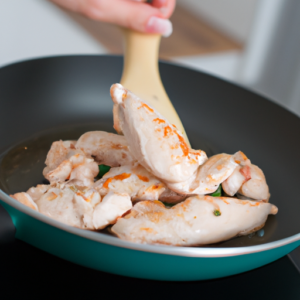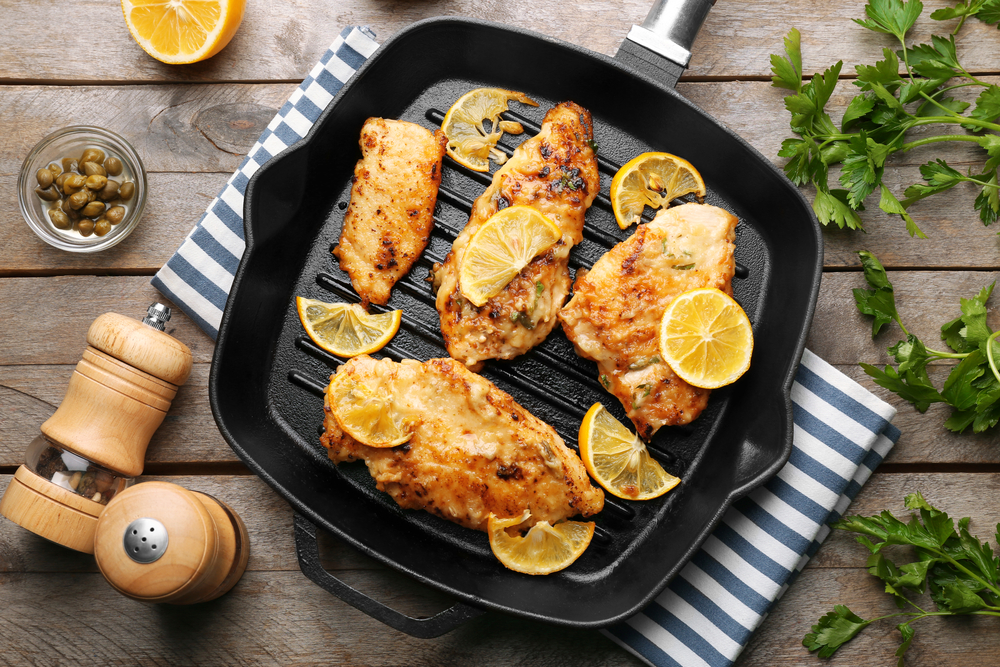Last Updated on February 1, 2023
Cooking chicken breast in a frying pan doesn’t have to be intimidating. With just a few simple steps and some basic kitchen supplies, you can master the art of cooking juicy and flavourful chicken breasts. In this blog post, we’ll walk you through everything from preparing your ingredients to serving suggestions – so if you’re ready to learn how to cook chicken breast using a frying pan, let’s get started.
Table of Contents:
- Preparing the Chicken
- Cooking the Chicken
- Checking Doneness
- FAQs in Relation to How to Cook Chicken Breast in a Frying Pan
- Conclusion
Preparing the Chicken
Before you begin cooking chicken, it is important to prepare the chicken properly. To do this, start by washing the chicken with cold water and a dish soap. Make sure to rinse off all of the soap before moving on to the next step. After rinsing, pat dry with paper towels or a clean kitchen towel.
Once your chicken is completely dry, season it generously with salt and pepper (or whatever spices you prefer). If you are using fresh herbs like rosemary or thyme, rub them into the skin of the bird for extra flavour. You can also add butter or oil under the skin if desired.
Finally, truss up your chicken so that its legs stay close together during roasting; this helps ensure even cooking as well as an attractive presentation when served.
Cooking the Chicken
Heating the Pan
To begin, heat up a large frying pan over medium-high heat. If you’re using an electric stovetop, set it to around 8 or 9 out of 10. For gas stoves, adjust the flame until it’s just below medium-high.
Adding Oil or Butter

Once your pan is hot enough, add oil or butter to coat the bottom of the pan evenly and prevent sticking. Use about 1 tablespoon for every chicken breast you plan on cooking. Swirl it around with a spatula until it melts and coats the entire surface area of your pan.
Placing Chicken in Pan
Place your chicken breasts into the heated skillet one at a time and season them with salt and pepper (or whatever other seasoning you prefer). Let them cook undisturbed for 3 minutes before flipping them over to their other side.
Flipping & Cooking Other Side
After 3 minutes have passed, use tongs or a spatula to flip each piece of chicken over onto its other side and let cook for another 3 minutes before checking doneness (see next section). Depending on how thick they are, they may need more than 6 minutes total cooking time – if so, continue flipping every few minutes until cooked through completely.
The best way to check if your chicken is done is by cutting it into one piece with a sharp knife – if there’s no pink inside, then they’re ready. Alternatively, use an instant-read thermometer inserted into the thickest part of the meat – when the temperature reads 165°F/74°C, then they are also done.
Checking Doneness

When it comes to cooking chicken, the last step is often the most important: checking doneness. This means making sure that your chicken has reached a safe internal temperature and is cooked through. The best way to do this is with a thermometer. Insert the thermometer into the thickest part of the meat, avoiding any bones or fat, and make sure that it reads at least 165°F (74°C). If you don’t have a thermometer handy, you can also check for juices running clear from when you cut into it.
If your chicken looks golden brown on top but still feels slightly soft when pressed down with tongs or a fork, then there’s a good chance that it isn’t done yet. To be extra certain, take out some of its juices and give them a taste – if they are pinkish in colour then your chicken needs more time in the oven. If all else fails and you’re not sure whether or not your chicken is cooked through properly, err on the side of caution by giving it an extra few minutes in the oven before serving up dinner
FAQs in Relation to How to Cook Chicken Breast in a Frying Pan
How long does it take to fry chicken breast in a frying pan?
Frying chicken breast in a frying pan is a relatively quick process. Depending on the size of the chicken breasts, it typically takes between 8-10 minutes to cook them through. To ensure even cooking, make sure to preheat your pan and use enough oil or butter to cover the bottom of the pan. Place each piece of chicken in the hot oil and let it cook for 4-5 minutes before flipping over and cooking for an additional 4-5 minutes until cooked through. Use a meat thermometer inserted into the thickest part of each breast to check that they have reached an internal temperature of 165°F (74°C).
Can you cook chicken breast in a frying pan?
Yes, you can cook chicken breast in a frying pan. All you need is some oil or butter to prevent the chicken from sticking and to help it brown. Start by heating your pan over medium-high heat before adding the oil or butter. Once hot, add the chicken breasts and season with salt and pepper. Cook for 3-4 minutes on each side until golden brown and cooked through – use a thermometer to check that the internal temperature has reached 165°F/74°C. Serve with your favourite sides for an easy meal.
Do you put oil in the pan when cooking chicken breast?
It is not necessary to put oil in the pan when cooking chicken breast. The natural fat content of the chicken will provide enough moisture and flavour for a delicious meal. If you choose to add oil, use an oil with a high smoke point, such as canola or vegetable oil. This will help prevent burning and sticking during the cooking process. Additionally, adding herbs or spices can enhance flavour without needing extra oils or fats.
Conclusion
With just a few steps, you can have juicy, flavourful chicken that’s perfect for any meal. Preparing the chicken properly will ensure it cooks evenly and quickly, while checking doneness ensures your dish is cooked through without drying out. Serve with your favourite sides or use it as an ingredient in other dishes for added flavour and nutrition. No matter how you choose to cook chicken breast in a frying pan, it’s sure to be an enjoyable experience.
Paul is the type of person who never met a problem he couldn’t fix. He can always be found tinkering with something in his house, even if it isn’t broken! His tips and tricks are often shared on our site. He’s the one you call when something breaks because he has been known to improvise fixes for everything from leaky faucets to malfunctioning dryers.

